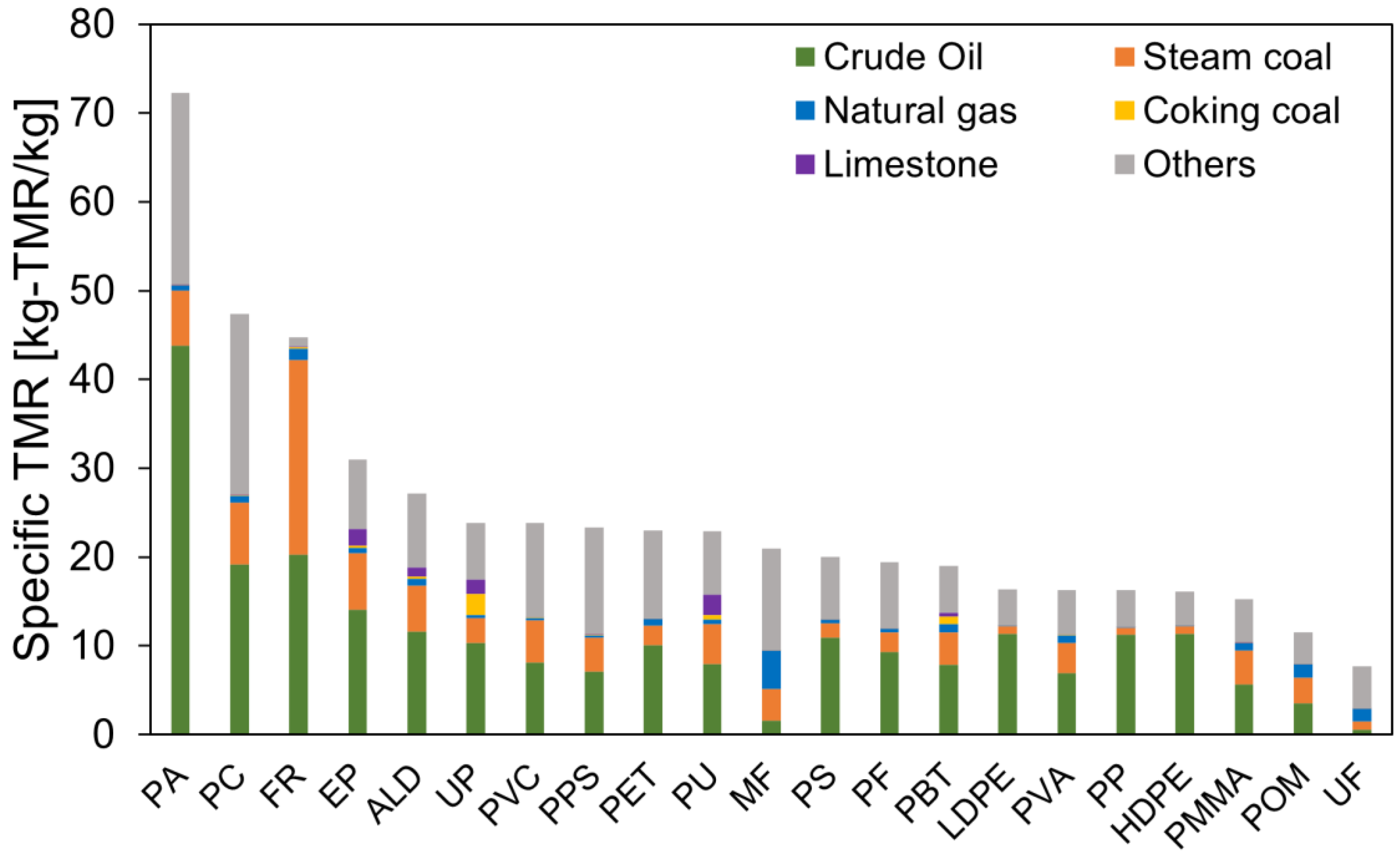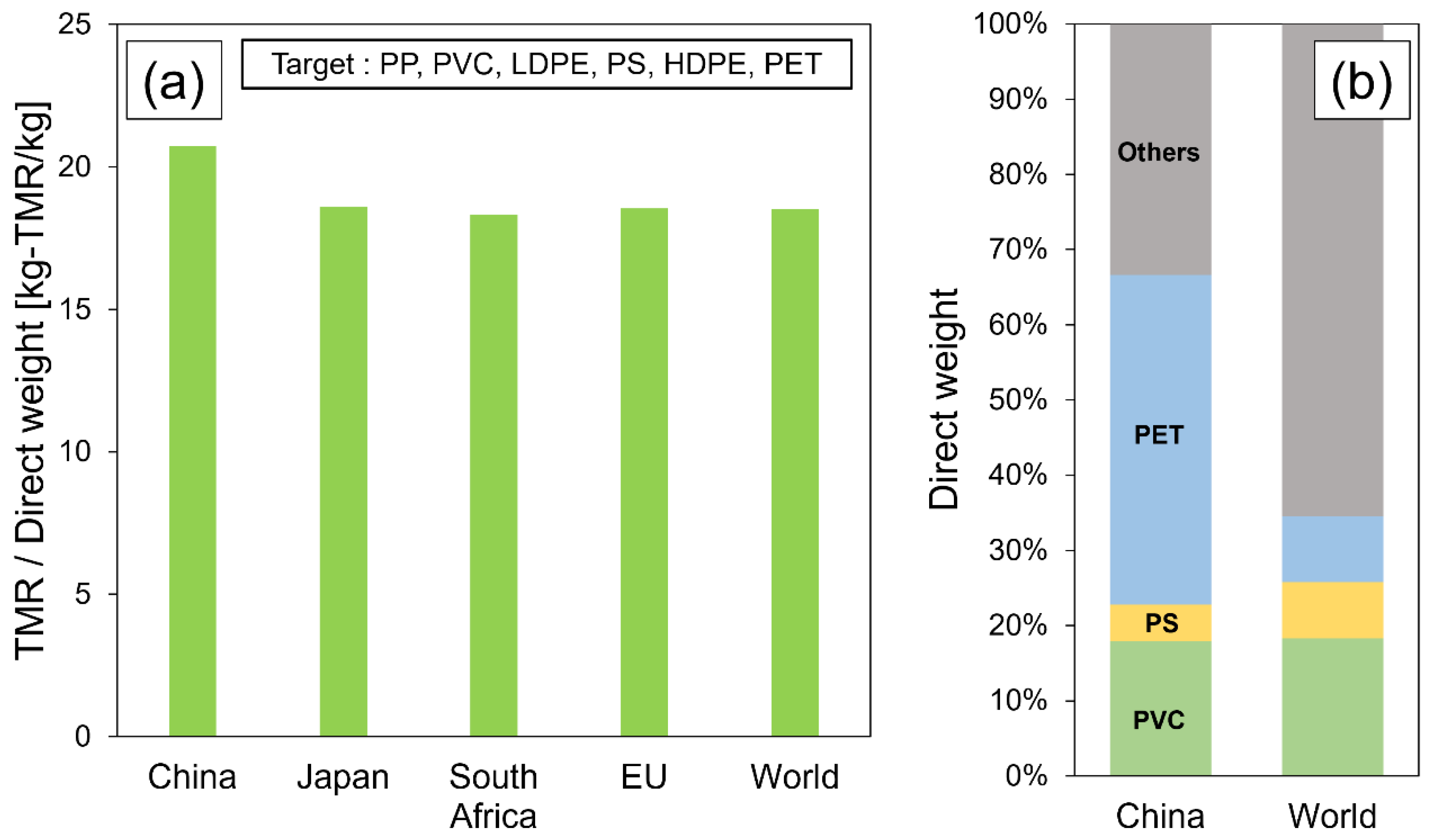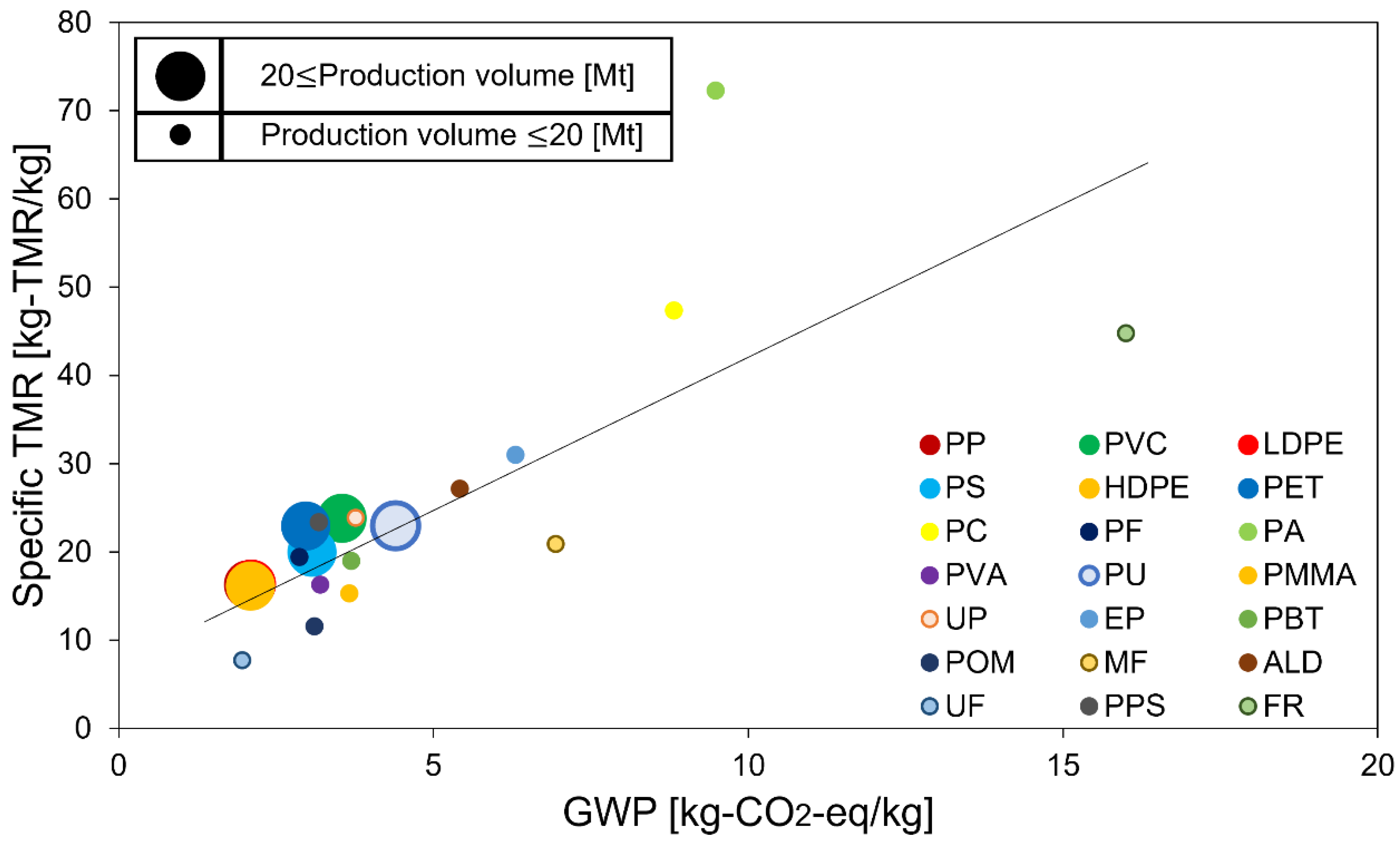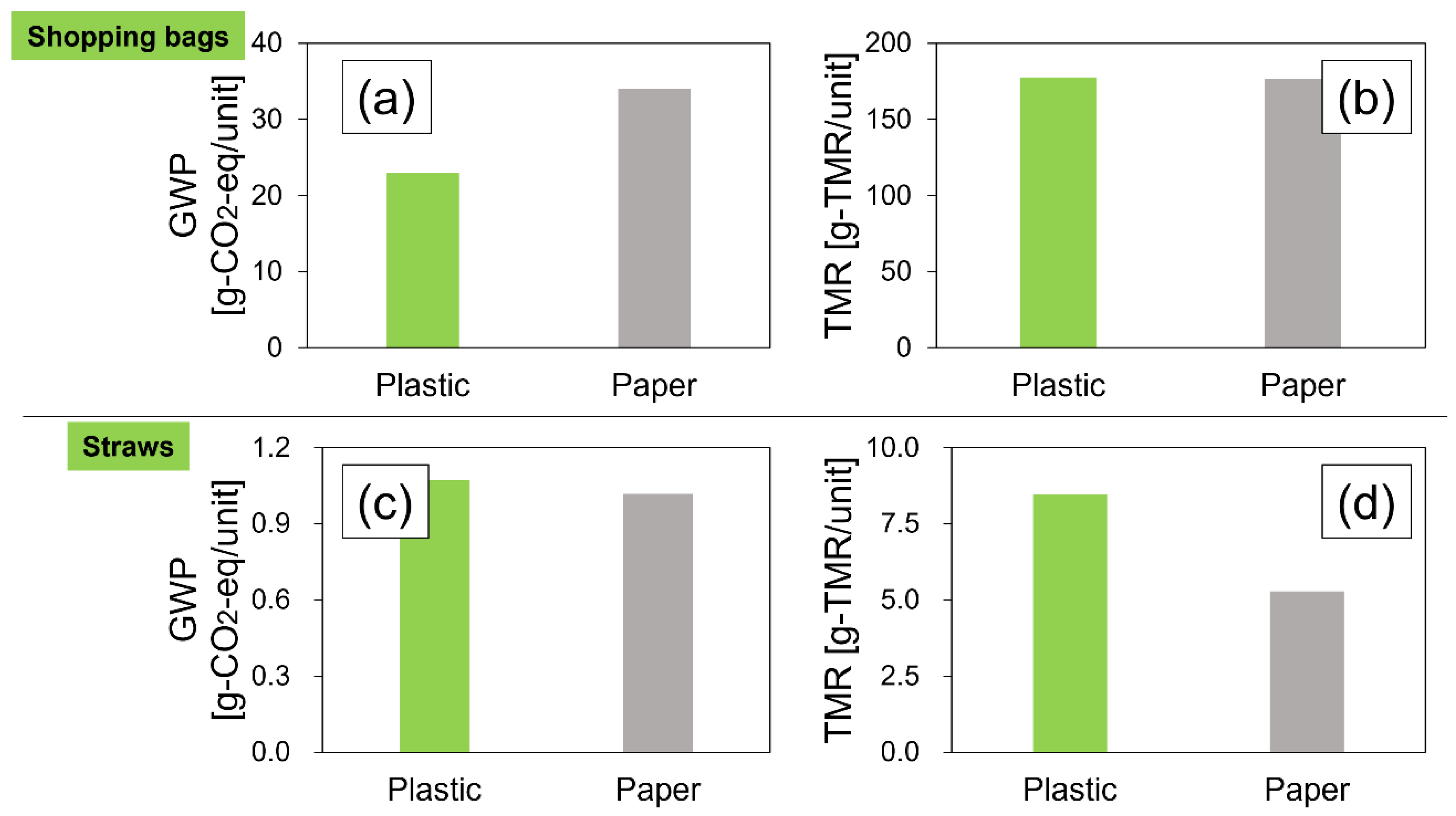Resource Intensity Analysis of Producing 21 Types of Plastic in Terms of Mining Activity
Abstract
1. Introduction
2. Methodology
2.1. Total Material Requirement
2.2. Inventory Data
2.3. Target for Evaluation
3. Results
4. Discussion
4.1. Application of TMR to Material Flow Analysis
4.2. Relationship between Specific TMR and GWP with Different Plastic Types
4.3. Plastic Alternative
4.4. Limitations
4.5. Summary
Supplementary Materials
Author Contributions
Funding
Institutional Review Board Statement
Informed Consent Statement
Data Availability Statement
Conflicts of Interest
References
- Bonilla, S.H.; Silva, H.R.O.; da Silva, M.T.; Goncalves, R.F.; Sacomano, J.B. Industry 4.0 and Sustainability Implications: A Scenario-Based Analysis of the Impacts and Challenges. Sustainability 2018, 10, 3740. [Google Scholar] [CrossRef]
- Sarkis, J.; Zhu, Q. Environmental sustainability and production: Taking the road less travelled. Int. J. Prod. Res. 2018, 56, 743–759. [Google Scholar] [CrossRef]
- Jiang, F.; Li, T.; Li, Y.J.; Zhang, Y.; Gong, A.; Dai, J.Q.; Hitz, E.; Luo, W.; Hu, L.B. Wood-Based Nanotechnologies toward Sustainability. Adv. Mater. 2018, 30, 1703453. [Google Scholar] [CrossRef] [PubMed]
- Aydemir, C.; Yenidoğan, S.; Tutak, D. Sustainability in the Print and Packaging Industry. Cellul. Chem. Technol. 2023, 57, 565–577. [Google Scholar] [CrossRef]
- Chang, S.H. Plastic waste as pyrolysis feedstock for plastic oil production: A review. Sci. Total Environ. 2023, 877, 162719. [Google Scholar] [CrossRef]
- Biegańska, J.; Barański, K.; Hebda, K.; Pytlik, M. Thermodynamic Assessment of the Impact of Selected Plastics on the Energy Parameters of Explosives. Energies 2022, 15, 9583. [Google Scholar] [CrossRef]
- Volk, R.; Stallkamp, C.; Steins, J.J.; Yogish, S.P.; Muller, R.C.; Stapf, D.; Schultmann, F. Techno-economic assessment and comparison of different plastic recycling pathways: A German case study. J. Ind. Ecol. 2021, 25, 1318–1337. [Google Scholar] [CrossRef]
- Huang, S.M.; Wang, H.C.; Ahmad, W.; Ahmad, A.; Vatin, N.I.; Mohamed, A.M.; Deifalla, A.F.; Mehmood, I. Plastic Waste Management Strategies and Their Environmental Aspects: A Scientometric Analysis and Comprehensive Review. Int. J. Environ. Res. Public Health 2022, 19, 4556. [Google Scholar] [CrossRef]
- Hannah, R.; Veronika, S.; Max, R. Plastic Pollution. Our World in Data. 2022. Available online: https://ourworldindata.org/plastic-pollution?utm_source=newsletter (accessed on 1 December 2023).
- Drewniok, M.P.; Gao, Y.; Cullen, J.M.; Serrenho, A.C. What to Do about Plastics? Lessons from a Study of United Kingdom Plastics Flows. Environ. Sci. Technol. 2023, 57, 4513–4521. [Google Scholar] [CrossRef]
- Cozar, A.; Echevarria, F.; Gonzalez-Gordillo, J.I.; Irigoien, X.; Ubeda, B.; Hernandez-Leon, S.; Palma, A.T.; Navarro, S.; Garcia-de-Lomas, J.; Ruiz, A.; et al. Plastic debris in the open ocean. Proc. Natl. Acad. Sci. USA 2014, 111, 10239–10244. [Google Scholar] [CrossRef]
- Jambeck, J.R.; Geyer, R.; Wilcox, C.; Siegler, T.R.; Perryman, M.; Andrady, A.; Narayan, R.; Law, K.L. Plastic waste inputs from land into the ocean. Science 2015, 347, 768–771. [Google Scholar] [CrossRef]
- Baulch, S.; Perry, C. Evaluating the impacts of marine debris on cetaceans. Mar. Pollut. Bull. 2014, 80, 210–221. [Google Scholar] [CrossRef] [PubMed]
- Kajaste, R.; Oinas, P. Plastics value chain–Abatement of greenhouse gas emissions. AIMS Environ. Sci. 2021, 8, 371–392. [Google Scholar] [CrossRef]
- Howard, B.C.; Gibbens, S.; Zachos, E.; Parker, L. A Running List of Action on Plastic Pollution; National Geographic Society: Washington, DC, USA, 2019. [Google Scholar]
- Pettipas, S.; Bernier, M.; Walker, T.R. A Canadian policy framework to mitigate plastic marine pollution. Mar. Policy 2016, 68, 117–122. [Google Scholar] [CrossRef]
- Walker, T.R.; Fequet, L. Current trends of unsustainable plastic production and micro(nano)plastic pollution. TrAC Trends Anal. Chem. 2023, 160, 116984. [Google Scholar] [CrossRef]
- Dietrich, K.; Dumont, M.-J.; Del Rio, L.F.; Orsat, V. Producing PHAs in the bioeconomy—Towards a sustainable bioplastic. Sustain. Prod. Consum. 2017, 9, 58–70. [Google Scholar] [CrossRef]
- Vanapalli, K.R.; Sharma, H.B.; Ranjan, V.P.; Samal, B.; Bhattacharya, J.; Dubey, B.K.; Goel, S. Challenges and strategies for effective plastic waste management during and post COVID-19 pandemic. Sci. Total Environ. 2021, 750, 141514. [Google Scholar] [CrossRef]
- Wu, C.Y.; Hu, M.C.; Ni, F.C. Supporting a circular economy: Insights from Taiwan’s plastic waste sector and lessons for developing countries. Sustain. Prod. Consum. 2021, 26, 228–238. [Google Scholar] [CrossRef] [PubMed]
- Zhu, Z.; Liu, W.; Ye, S.; Batista, L. Packaging design for the circular economy: A systematic review. Sustain. Prod. Consum. 2022, 32, 817–832. [Google Scholar] [CrossRef]
- Khan, O.; Daddi, T.; Slabbinck, H.; Kleinhans, K.; Vazquez-Brust, D.; De Meester, S. Assessing the determinants of intentions and behaviors of organizations towards a circular economy for plastics. Resour. Conserv. Recycl. 2020, 163, 105069. [Google Scholar] [CrossRef]
- van Oosterhout, L.; Dijkstra, H.; Borst, D.; Duijndam, S.; Rehdanz, K.; van Beukering, P. Triggering sustainable plastics consumption behavior: Identifying consumer profiles across Europe and designing strategies to engage them. Sustain. Prod. Consum. 2023, 36, 148–160. [Google Scholar] [CrossRef]
- Van Eygen, E.; Feketitsch, J.; Laner, D.; Rechberger, H.; Fellner, J. Comprehensive analysis and quantification of national plastic flows: The case of Austria. Resour. Conserv. Recycl. 2017, 117, 183–194. [Google Scholar] [CrossRef]
- Joosten, L.; Hekkert, M.; Worrell, E. Assessment of the plastic flows in The Netherlands using STREAMS. Resour. Conserv. Recycl. 2000, 30, 135–161. [Google Scholar] [CrossRef]
- Mutha, N.H.; Patel, M.; Premnath, V. Plastics materials flow analysis for India. Resour. Conserv. Recycl. 2006, 47, 222–244. [Google Scholar] [CrossRef]
- Vujic, G.; Jovicic, N.; Babic, M.; Stanisavljevic, N.; Batinic, B.; Pavlovic, A. Assessment of plastic flows and stocks in Serbia using material flow analysis. Therm. Sci. 2010, 14, 89–95. [Google Scholar] [CrossRef]
- Bureecam, C.; Chaisomphob, T.; Sungsomboon, P.-Y. Material flows analysis of plastic in Thailand. Therm. Sci. 2018, 22, 2379–2388. [Google Scholar] [CrossRef]
- Olatayo, K.I.; Mativenga, P.T.; Marnewick, A.L. Comprehensive evaluation of plastic flows and stocks in South Africa. Resour. Conserv. Recycl. 2021, 170, 105567. [Google Scholar] [CrossRef]
- Siddique, S.; Roy, B.B.; Zaman, S.; Khan, A.; Al Alam, A.; Chowdhury, R.B.; Biswas, K.F.; Hossain, M.M.; Murakami, S.; Sujauddin, M. Discerning the circularity of the plastic industry in Bangladesh through the lens of material flow analysis. Sustain. Prod. Consum. 2022, 33, 700–715. [Google Scholar] [CrossRef]
- Tod, H.; Plastic: It’s Not All the Same. Plastic Oceans. 2021. Available online: https://plasticoceans.org/7-types-of-plastic/ (accessed on 1 December 2023).
- Plastics for Change. The 7 Different Types of Plastic. Plastics for Change. 2021. Available online: https://www.plasticsforchange.org/blog/different-types-of-plastic (accessed on 1 December 2023).
- Heller, M.C.; Mazor, M.H.; Keoleian, G.A. Plastics in the US: Toward a material flow characterization of pro-duction, markets and end of life. Environ. Res. Lett. 2020, 15, 094034. [Google Scholar] [CrossRef]
- Hsu, W.-T.; Domenech, T.; McDowall, W. How circular are plastics in the EU?: MFA of plastics in the EU and pathways to circularity. Clean. Environ. Syst. 2020, 2, 100004. [Google Scholar] [CrossRef]
- Patel, M.K.; Jochem, E.; Radgen, P.; Worrell, E. Plastics streams in Germany–An analysis of production, consumption and waste generation. Resour. Conserv. Recycl. 1998, 24, 191–215. [Google Scholar] [CrossRef]
- Luan, X.; Cui, X.; Zhang, L.; Chen, X.; Li, X.; Feng, X.; Chen, L.; Liu, W.; Cui, Z. Dynamic material flow analysis of plastics in China from 1950 to 2050. J. Clean. Prod. 2021, 327, 129492. [Google Scholar] [CrossRef]
- Muise, I.; Adams, M.; Côté, R.; Price, G. Attitudes to the recovery and recycling of agricultural plastics waste: A case study of Nova Scotia, Canada. Resour. Conserv. Recycl. 2016, 109, 137–145. [Google Scholar] [CrossRef]
- Dunkelberg, H.; Weiß, T.; Mazurek, F. Energy- and ecologically-oriented selection of plastic materials. Procedia Manuf. 2019, 33, 240–247. [Google Scholar] [CrossRef]
- Kosai, S.; Yamasue, E. Global warming potential and total material requirement in metal production: Identification of changes in environmental impact through metal substitution. Sci. Total Environ. 2019, 651, 1764–1775. [Google Scholar] [CrossRef] [PubMed]
- Kosai, S.; Matsui, K.; Matsubae, K.; Yamasue, E.; Nagasaka, T. Natural resource use of gasoline, hybrid, electric and fuel cell vehicles considering land disturbances. Resour. Conserv. Recycl. 2021, 166, 105256. [Google Scholar] [CrossRef]
- Nakagawa, N.; Kosai, S.; Yamasue, E. Life cycle resource use of nuclear power generation considering total material requirement. J. Clean. Prod. 2022, 363, 132530. [Google Scholar] [CrossRef]
- Taelman, S.E.; Schaubroeck, T.; De Meester, S.; Boone, L.; Dewulf, J. Accounting for land use in life cycle assessment: The value of NPP as a proxy indicator to assess land use impacts on ecosystems. Sci. Total Environ. 2016, 550, 143–156. [Google Scholar] [CrossRef] [PubMed]
- Koellner, T.; de Baan, L.; Beck, T.; Brandão, M.; Civit, B.; Margni, M.; Canals, L.M.I.; Saad, R.; de Souza, D.M.; Müller-Wenk, R. UNEP-SETAC guideline on global land use impact assessment on biodiversity and ecosystem services in LCA. Int. J. Life Cycle Assess. 2013, 18, 1188–1202. [Google Scholar] [CrossRef]
- Canals, L.M.I.; Bauer, C.; Depestele, J.; Dubreuil, A.; Knuchel, R.F.; Gaillard, G.; Michelsen, O.; Müller-Wenk, R.; Rydgren, B. Key Elements in a Framework for Land Use Impact Assessment within LCA (11 pp). Int. J. Life Cycle Assess. 2007, 12, 5–15. [Google Scholar] [CrossRef]
- Mattila, T.; Helin, T.; Antikainen, R. Land use indicators in life cycle assessment: A case study on beer production. Int. J. Life Cycle Assess. 2012, 17, 277–286. [Google Scholar] [CrossRef]
- Aleksandrowicz, L.; Green, R.; Joy, E.J.M.; Smith, P.; Haines, A. The Impacts of Dietary Change on Greenhouse Gas Emissions, Land Use, Water Use, and Health: A Systematic Review. PLoS ONE 2016, 11, e0165797. [Google Scholar] [CrossRef]
- Kosai, S.; Badin, A.B.; Qiu, Y.; Matsubae, K.; Suh, S.; Yamasue, E. Evaluation of resource use in the household lighting sector in Malaysia considering land disturbances through mining activities. Resour. Conserv. Recycl. 2021, 166, 105343. [Google Scholar] [CrossRef]
- Bringezu, S.; Schutz, H.; Steger, S.; Baudisch, J. International comparison of resource use and its relation to economic growth: The development of total material requirement, direct material inputs and hidden flows and the structure of TMR. Ecol. Econ. 2004, 51, 97–124. [Google Scholar] [CrossRef]
- Nakajima, K.; Noda, S.; Nansai, K.; Matsubae, K.; Takayanagi, W.; Tomita, M. Global Distribution of Used and Unused Extracted Materials Induced by Consumption of Iron, Copper, and Nickel. Environ. Sci. Technol. 2019, 53, 1555–1563. [Google Scholar] [CrossRef]
- Lebre, E.; Corder, G.; Golev, A. The Role of the Mining Industry in a Circular Economy: A Framework for Resource Management at the Mine Site Level. J. Ind. Ecol. 2017, 21, 662–672. [Google Scholar] [CrossRef]
- Bridge, G. CONTESTED TERRAIN: Mining and the Environment. Annu. Rev. Environ. Resour. 2004, 29, 205–259. [Google Scholar] [CrossRef]
- Schandl, H.; West, J. Resource use and resource efficiency in the Asia–Pacific region. Glob. Environ. Chang. 2010, 20, 636–647. [Google Scholar] [CrossRef]
- Fischer-Kowalski, M.; Krausmann, F.; Giljum, S.; Lutter, S.; Mayer, A.; Bringezu, S.; Moriguchi, Y.; Schütz, H.; Schandl, H.; Weisz, H. Methodology and Indicators of Economy-wide Material Flow Accounting. J. Ind. Ecol. 2011, 15, 855–876. [Google Scholar] [CrossRef]
- Nakajima, K.; Halada, K.; Ijima, K.; Nagasaka, T. Estimation of Total Materials Requirement: Energy Resources and Industrial Materials. J. Life Cycle Assess. Jpn. 2006, 2, 152–158. [Google Scholar] [CrossRef][Green Version]
- Halada, K.; Ijima, K.; Katagiri, N.; Okura, T. An Approximate Estimation of Total Materials Requirement of Metals. J. Jpn. Inst. Met. Mater. 2001, 65, 564–570. [Google Scholar] [CrossRef]
- Panesar, D.K.; Seto, K.E.; Churchill, C.J. Impact of the selection of functional unit on the life cycle assessment of green concrete. Int. J. Life Cycle Assess. 2017, 22, 1969–1986. [Google Scholar] [CrossRef]
- Xia, Q.Q.; Chen, C.J.; Yao, Y.G.; Li, J.G.; He, S.M.; Zhou, Y.B.; Li, T.; Pan, X.J.; Yao, Y.; Hu, L.B. A strong, biodegradable and recyclable lignocellulosic bioplastic. Nat. Sustain. 2021, 4, 627–635. [Google Scholar] [CrossRef]
- KDA Corporation. Basic Knowledge of Plastics Physical Properties of Plastics. KDA Corporation. Available online: https://www.kda1969.com/materials/ (accessed on 1 December 2023).
- Craig, F.; How Plastics Work. HowStuffWorks. Available online: https://science.howstuffworks.com/plastic.htm/printable (accessed on 1 December 2023).
- Sato, H.; Ogawa, H. Review on Development of Polypropylene Manufacturing Process; Sumitomo Chemical Co., Ltd.: Tokyo, Japan, 2009. [Google Scholar]
- Ren, T.; Patel, M.K. Basic petrochemicals from natural gas, coal and biomass: Energy use and CO2 emissions. Resour. Conserv. Recycl. 2009, 53, 513–528. [Google Scholar] [CrossRef]
- Carwile, J.L.; Luu, H.T.; Bassett, L.S.; Driscoll, D.A.; Yuan, C.; Chang, J.Y.; Ye, X.; Calafat, A.M.; Michels, K.B. Polycarbonate Bottle Use and Urinary Bisphenol A Concentrations. Environ. Health Perspect. 2009, 117, 1368–1372. [Google Scholar] [CrossRef] [PubMed]
- Laskar, N.; Kumar, U. Plastics and microplastics: A threat to environment. Environ. Technol. Innov. 2019, 14, 100352. [Google Scholar] [CrossRef]
- Antonetti, E.; Iaquaniello, G.; Salladini, A.; Spadaccini, L.; Perathoner, S.; Centi, G. Waste-to-Chemicals for a Circular Economy: The Case of Urea Production (Waste-to-Urea). ChemSusChem 2017, 10, 912–920. [Google Scholar] [CrossRef]
- Ferro, W.P.; e Silva, L.G.A.; Wiebeck, H. Uso da cinza da casca de arroz como carga em matrizes de poliamida 6 e poliamida 6.6. Polim.-Cienc. Tecnol. 2007, 17, 240–243. [Google Scholar] [CrossRef]
- Zulfiqar, S.; Ahmad, Z.; Ishaq, M.; Sarwar, M.I. Aromatic–aliphatic polyamide/montmorillonite clay nanocomposite materials: Synthesis, nanostructure and properties. Mater. Sci. Eng. A-Struct. Mater. Prop. Microstruct. Process. 2009, 525, 30–36. [Google Scholar] [CrossRef]
- Japan Petrochemical Industry Association. Petrochemicals and Plastics; Japan Petrochemical Industry Association: Tokyo, Japan, 2023. [Google Scholar]
- Plastics Europe. Plastics–The Facts 2022; Plastics Europe: Nieuwegein, The Netherlands, 2022. [Google Scholar]
- Shah, P.; Yang, J.Z. It Takes Two to Tango: How Ability and Morality Shape Consumers’ Willingness to Refill and Reuse. Environ. Manag. 2023, 73, 311–322. [Google Scholar] [CrossRef]
- Di Paolo, L.; Abbate, S.; Celani, E.; Di Battista, D.; Candeloro, G. Carbon Footprint of Single-Use Plastic Items and Their Substitution. Sustainability 2022, 14, 16563. [Google Scholar] [CrossRef]
- Klemeš, J.J.; Van Fan, Y.; Jiang, P. Plastics: Friends or foes? The circularity and plastic waste footprint. Energy Sources Part A Recover. Util. Environ. Eff. 2021, 43, 1549–1565. [Google Scholar] [CrossRef]
- Biona, J.B.M.M.; Gonzaga, J.A.; Ubando, A.T.; Tan, H.C. A comparative life cycle analysis of plastic and paper packaging bags in the Philippines. In Proceedings of the 2015 International Conference on Humanoid, Nanotechnology, Information Technology, Communication and Control, Environment and Management (HNICEM), Cebu, Philippines, 9–12 December 2015; IEEE: Piscataway, NJ, USA, 2015; pp. 1–6. [Google Scholar]
- Chitaka, T.Y.; Russo, V.; von Blottnitz, H. In pursuit of environmentally friendly straws: A comparative life cycle assessment of five straw material options in South Africa. Int. J. Life Cycle Assess. 2020, 25, 1818–1832. [Google Scholar] [CrossRef]
- Stafford, W.; Russo, V.; Nahman, A. A comparative cradle-to-grave life cycle assessment of single-use plastic shopping bags and various alternatives available in South Africa. Int. J. Life Cycle Assess. 2022, 27, 1213–1227. [Google Scholar] [CrossRef]
- OECD. Plastic Pollution Is Growing Relentlessly as Waste Management and Recycling Fall Short, Says OECD; OECD: Paris, France, 2022. [Google Scholar]
- American Chemistry Council. US Resin Production & Sales 2022 vs. 2021; American Chemistry Council: Washington, DC, USA, 2023. [Google Scholar]
- Lee, M.-Y.; Cho, N.-H.; Lee, S.-J.; Um, N.; Jeon, T.-W.; Kang, Y.-Y. Application of material flow analysis for plastic waste management in the Republic of Korea. J. Environ. Manag. 2021, 299, 113625. [Google Scholar] [CrossRef]






Disclaimer/Publisher’s Note: The statements, opinions and data contained in all publications are solely those of the individual author(s) and contributor(s) and not of MDPI and/or the editor(s). MDPI and/or the editor(s) disclaim responsibility for any injury to people or property resulting from any ideas, methods, instructions or products referred to in the content. |
© 2024 by the authors. Licensee MDPI, Basel, Switzerland. This article is an open access article distributed under the terms and conditions of the Creative Commons Attribution (CC BY) license (https://creativecommons.org/licenses/by/4.0/).
Share and Cite
Umesaki, T.; Kosai, S.; Kashiwakura, S.; Yamasue, E. Resource Intensity Analysis of Producing 21 Types of Plastic in Terms of Mining Activity. Sustainability 2024, 16, 2715. https://doi.org/10.3390/su16072715
Umesaki T, Kosai S, Kashiwakura S, Yamasue E. Resource Intensity Analysis of Producing 21 Types of Plastic in Terms of Mining Activity. Sustainability. 2024; 16(7):2715. https://doi.org/10.3390/su16072715
Chicago/Turabian StyleUmesaki, Taisuke, Shoki Kosai, Shunsuke Kashiwakura, and Eiji Yamasue. 2024. "Resource Intensity Analysis of Producing 21 Types of Plastic in Terms of Mining Activity" Sustainability 16, no. 7: 2715. https://doi.org/10.3390/su16072715
APA StyleUmesaki, T., Kosai, S., Kashiwakura, S., & Yamasue, E. (2024). Resource Intensity Analysis of Producing 21 Types of Plastic in Terms of Mining Activity. Sustainability, 16(7), 2715. https://doi.org/10.3390/su16072715





